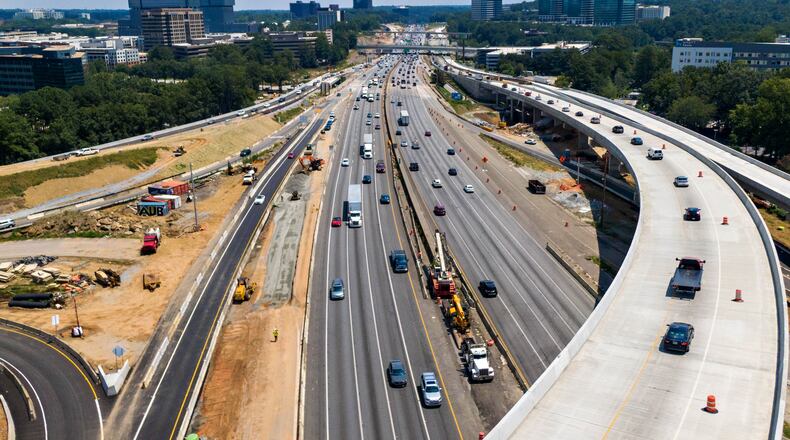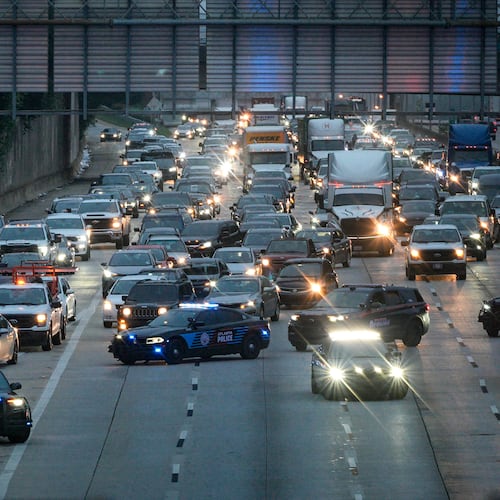UPDATE: Major lane closings on I-285 near Georgia 400 delayed until 2022
Traffic at one of the most congested interchanges in metro Atlanta is about to get dramatically worse as construction peaks at I-285 and Ga. 400.
The weekend after Labor Day, the Georgia Department of Transportation will shrink the Perimeter from five lanes to three lanes in each direction from Roswell Road to Ashford Dunwoody Road, creating a colossal headache for hundreds of thousands of motorists. And it won’t be a short-term hassle.
The reduction in lanes could last until next summer as construction delays push completion of the new interchange well into 2022. Until then, GDOT is begging commuters to stay away — to work from home, to find alternative routes or to travel at off-peak hours. If you can’t? Get ready to spend plenty of extra time in some of the world’s worst traffic.
“This is going to be a long-term, monumental (traffic) shift to get things finished,” GDOT spokesperson Natalie Dale said. “Do you really need to go through this interchange?”
Natalie Kaminsky of Roswell said traffic in the area is already horrible, and she dreads the changes to come.
“It’s very dangerous, and now you’re saying it’s going to be two lanes less?” Kaminsky said. “It’s a terrible situation.”
Motorists such as Kaminsky were dealing with horrible traffic long before work on the new interchange began in 2017. More than 400,000 vehicles pass through the I-285/Ga. 400 interchange each day, though it was designed to handle just 100,000.
To address the traffic bottleneck, GDOT is rebuilding the interchange and adding new lanes alongside I-285 and Ga. 400. The $800 million project also includes rebuilding nearby interchanges and replacing numerous bridges.
The construction zone stretches for miles on both highways. Traffic backs up frequently.
Kaminsky said GDOT needs more warning signs to direct traffic and to repaint lane markings that have faded. She said drivers who speed and don’t use turn signals make it worse. She’s stopped patronizing a hair salon in Smyrna because of the construction and avoids the interchange when she can.
“It is hair-raising to drive through there,” she said. “For me to get to the 285 west exit (from Ga. 400) is just horrible.”
It’s about to get worse.
The next phase of construction involves replacing I-285 bridges over Glenridge Drive, Ga. 400 and Peachtree Dunwoody Road. The weekend after Labor Day, GDOT will reduce I-285 from five lanes to three in each direction through the area.
At first, GDOT will close the two inside lanes of the Perimeter in both directions. When work on the inside lanes of the new bridges is done, traffic will shift and GDOT will close the two outside lanes.
Reducing the number of lanes by 40% will have a dramatic effect on traffic, and GDOT hopes people will avoid the area if they can. The agency may have caught a break of sorts — because of the recent resurgence of COVID-19, some companies are reconsidering plans to reopen corporate offices in September.
GDOT urges those who can’t work at home to drive at off-peak hours or to find alternative routes, if possible.
For those who must travel through the interchange, GDOT advises motorists to give themselves an extra half-hour to get where they’re going. Though the worst traffic will be on the Perimeter, traffic on Ga. 400 also will be affected.
“If we can get them to spread out, use those alternative routes, the pain will be somewhat diminished,” said Jeff Woodward of Jacobs Consulting, the construction manager on the project.
Credit: HYOSUB SHIN / AJC
Credit: HYOSUB SHIN / AJC
Until recently, the bridge work was supposed to be finished by the end of this year, when the entire project was set to open to traffic. But North Perimeter Contractors, which is doing the work, recently told GDOT that construction of the new interchange could drag on until the third quarter of 2022.
GDOT now says the I-285 lanes will be reduced through June.
“That’s going to be a disaster,” said Greg Kavouras of Roswell, who drives through the interchange a couple of times a week. “285 on the top end is notorious for being one of the worst bottlenecks. Now we’re going to make it 40% worse?”
Ann Hanlon, executive director of the Perimeter Community Improvement Districts, was more guarded in her assessment of the impact on businesses near the interchange.
“The bottom line is, this is a very complex project being done at a very complicated time,” Hanlon said. “Our vision is long-term. We know these lane closures are going to be temporary. But they will eventually result in a project that makes this market one of the most attractive in metro Atlanta.”
I-285/Ga.400 construction: What’s next
What: The Georgia Department of Transportation will reduce the number of lanes on I-285 from five to three from Roswell Road to Ashford Dunwoody Road.
When: The closures are tentatively set to begin the weekend after Labor Day.
How long: The lane closures are expected to last through June.
Impact: Expect substantial delays on I-285 and Ga. 400. GDOT urges motorists to find alternative routes or travel at off-peak times. If they must use the interchange, GDOT advises motorists to give themselves an extra half-hour to get where they’re going.
About the Author
The Latest
Featured




